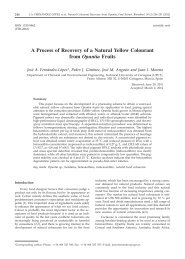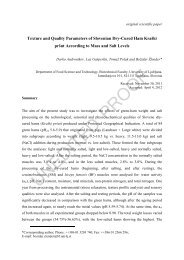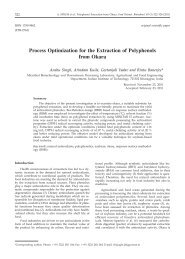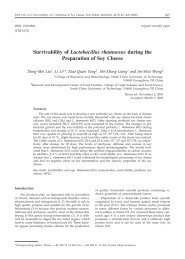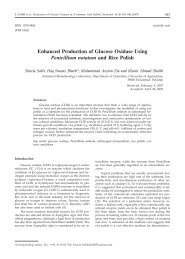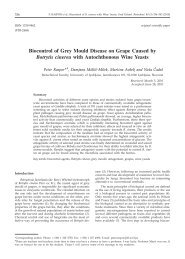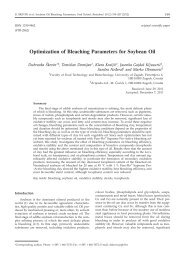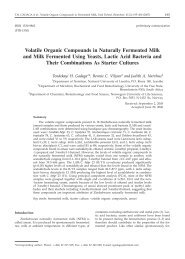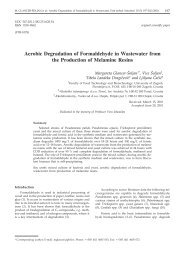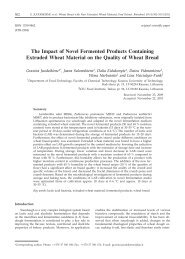152 A. WEISS et al.: <strong>Selective</strong> <strong>Media</strong> <strong>for</strong> <strong>Enumeration</strong> <strong>of</strong> Probiotic Enterococci, <strong>Food</strong> Technol. Biotechnol. 43 (2) 147–155 (2005)Bile esculin (BE) agarOn bile esculin (BE) agar, enterococci grew as colonies<strong>of</strong> small to large size and white colour, only E. casseliflavusexhibited light brown and E. mundtii yellowpigmented colonies. The colonies <strong>of</strong> all strains were glistening.With <strong>the</strong> exception <strong>of</strong> E. avium, strong hydrolysis<strong>of</strong> esculin was observed. Seven strains <strong>of</strong> lactobacilli andsix strains <strong>of</strong> pediococci grew on BE medium. L. plantarumcould not be distinguished macroscopically fromenterococci, due to its ability to hydrolyse esculin andits small colony size.Bile esculin azide (ECSA) agarThis medium was one <strong>of</strong> <strong>the</strong> tested <strong>for</strong>mulations <strong>of</strong>bile esculin azide (BEA) agar. Most <strong>of</strong> <strong>the</strong> E. faeciumstrains grew on ECSA <strong>for</strong>ming medium to large size colonies.The colonies <strong>of</strong> E. casseliflavus were brown and<strong>the</strong> colonies <strong>of</strong> E. mundtii were yellow. All enterococciwith <strong>the</strong> exception <strong>of</strong> E. gallinarum exhibited strong hydrolysis<strong>of</strong> esculin. Three Lactobacillus and six Pediococcusstrains displayed minimal growth under <strong>the</strong> givenconditions. The strains L. plantarum, P. dextrinicus and P.pentosaceus, which showed strong hydrolysis <strong>of</strong> esculin,could be distinguished from enterococci by <strong>the</strong>ir colonysize.Bile esculin azide (D-Cocc) agarThis medium was <strong>the</strong> second <strong>of</strong> <strong>the</strong> tested <strong>for</strong>mulations<strong>of</strong> bile esculin azide (BEA) agar. Few enterococcishowed poor growth (small colonies), but most grew onD-coccosel agar as medium-sized colonies, exhibitingstrong hydrolysis <strong>of</strong> esculin. E. mundtii showed lightbrown colonies. Two strains <strong>of</strong> lactobacilli and fourstrains <strong>of</strong> pediococci were able to grow under <strong>the</strong> specifiedconditions, but did not hydrolyse esculin. Only L.plantarum exhibited strong esculin hydrolysis, and couldbe distinguished from enterococci by its colony size.Cephalexin aztreonam arabinose (CAA) agarOn CAA agar E. faecium grew as white colonies <strong>of</strong>pinpoint to medium size. E. mundtii displayed yellowpigmented colonies. For some enterococci acidificationwas observed. Growth was detected <strong>for</strong> eight strains <strong>of</strong>lactobacilli and seven strains <strong>of</strong> pediococci. They allgrew as pinpoint colonies, some exhibiting acidification.Enterococci, <strong>the</strong>re<strong>for</strong>e, could not be distinguished macroscopicallyfrom lactobacilli and pediococci on CAAmedium.Chromocult enterococci (CE) agarOn this agar all enterococci grew as blue colonies <strong>of</strong>pinpoint to large size. Three strains <strong>of</strong> lactobacilli andfive strains <strong>of</strong> pediococci exhibited growth on this medium.L. casei, L. plantarum, P. dextrinicus and two strains<strong>of</strong> P. pentosaceus could not be distinguished from enterococcimacroscopically.Citrate Tween carbonate azide (CATC) agarOn CATC medium, enterococci appeared as colonies<strong>of</strong> various sizes (pinpoint to medium) and colours(rosy to dark red). Only enterococci were able to growon this medium, but on account <strong>of</strong> <strong>the</strong> small colonysizes <strong>the</strong> plates were difficult to evaluate. Under <strong>the</strong>given test conditions, CATC medium displayed <strong>the</strong> bestselectivity.mE (mE) agarEnterococci grew as pinpoint to large size colonies<strong>of</strong> rosy to dark red colour on mE medium, some colonieswere thus too small <strong>for</strong> colony counting. The colonies<strong>of</strong> <strong>the</strong> type strains <strong>of</strong> E. durans and E. gallinarumwere surrounded by light red halos. The type strain <strong>of</strong>L. plantarum and five strains <strong>of</strong> pediococci grew on mEmedium. They were distinguishable from enterococci.Fluorescent gentamicin thallous carbonate (fGTC) agarMost enterococci grew on fGTC medium as whitecolonies. E. casseliflavus and E. mundtii exhibited yellowpigmented colonies. For some enterococci fluorescencewas observed. Seven strains <strong>of</strong> lactobacilli, six pediococcalstrains and S. <strong>the</strong>rmophilus grew on fGTC medium.All <strong>the</strong>se strains <strong>for</strong>med pinpoint-sized colonies andcould <strong>the</strong>re<strong>for</strong>e be distinguished from enterococci.Kanamycin esculin azide (KEA) agarAll enterococci grew on KEA medium as white colonies<strong>of</strong> pinpoint to large size except E. mundtii, whichexhibited yellow colony colour. For two strains <strong>of</strong> E. faecalisand <strong>for</strong> E. mundtii dark centres <strong>of</strong> <strong>the</strong> colonies wereobserved. With <strong>the</strong> exception <strong>of</strong> E. avium and E. malodoratus,all enterococci exhibited strong hydrolysis <strong>of</strong> esculin.Eight strains <strong>of</strong> lactobacilli and six strains <strong>of</strong> pediococcigrew on KEA medium. However, <strong>the</strong>y could notbe distinguished from enterococci macroscopically.KF (KF) agarEnterococci grew as pinpoint to large size colonieson KF medium. The colour <strong>of</strong> <strong>the</strong> colonies ranged frompink to dark red. For <strong>the</strong> type strains <strong>of</strong> E. faecalis and E.hirae red and pink halos <strong>of</strong> <strong>the</strong> colonies, respectively,could be observed. Some strains <strong>of</strong> E. faecium <strong>for</strong>medcolonies with light zones. Acidification <strong>of</strong> <strong>the</strong> mediumsurrounding <strong>the</strong> colonies was observed by <strong>the</strong> change incolour <strong>of</strong> <strong>the</strong> indicator dye to yellow. Three strains <strong>of</strong>lactobacilli and five strains <strong>of</strong> pediococci grew on KFmedium, <strong>of</strong> which only P. dextrinicus could not be distinguishedmacroscopically from enterococci.Slanetz Bartley (SB) agarEnterococci grew on SB medium as rosy to dark redcolonies <strong>of</strong> pinpoint to medium size. Colonies <strong>of</strong> severalstrains <strong>of</strong> E. faecium were surrounded by light peripheries.Again, <strong>the</strong> enterococcal colonies were too small <strong>for</strong>easy evaluation. Two strains <strong>of</strong> lactobacilli and five strains<strong>of</strong> pediococci grew on SB medium. They all <strong>for</strong>med pinpoint-sized,white colonies. As <strong>the</strong> E. faecium strain En3showed <strong>the</strong>se characteristics as well, <strong>the</strong>se microorganismscould not be macroscopically distinguished fromenterococci.Merckoplate Barnes (BA) agarEnterococci grew on BA medium as colonies <strong>of</strong> pinpointto medium size. The colony colour ranged fromwhite via rosy to dark red. The colonies <strong>of</strong> several strainswere surrounded by light peripheries. Eleven strains <strong>of</strong>lactobacilli and seven strains <strong>of</strong> pediococci grew on BAmedium. They all exhibited white colony colour and
A. WEISS et al.: <strong>Selective</strong> <strong>Media</strong> <strong>for</strong> <strong>Enumeration</strong> <strong>of</strong> Probiotic Enterococci, <strong>Food</strong> Technol. Biotechnol. 43 (2) 147–155 (2005)153pinpoint or small colony size and could <strong>the</strong>re<strong>for</strong>e not bedistinguished from enterococci.Oxolonic acid esculin azide (OAA) agarEnterococcal colonies grown on OAA medium were<strong>of</strong> pinpoint to large size and <strong>of</strong> white colour, with <strong>the</strong>exception <strong>of</strong> E. mundtii, which produced yellow colonies.The colonies <strong>of</strong> <strong>the</strong> type strain <strong>of</strong> E. casseliflavus and <strong>of</strong>E. faecium En24 showed dark centres. Three strains <strong>of</strong>lactobacilli and five strains <strong>of</strong> pediococci grew on OAA--medium. They could not be distinguished macroscopicallyfrom enterococci.Comparative testing <strong>of</strong> three selective media andBHI agarOn account <strong>of</strong> <strong>the</strong> results <strong>of</strong> this first test series, <strong>the</strong>three selective media ECSA, CATC and mE were selected<strong>for</strong> fur<strong>the</strong>r evaluation. The productivities <strong>of</strong> all threeselective media were close to 100 % (ECSA: 95.2 %,CATC: 111.9 % and mE: 96.4 %). Comparable resultswere obtained in <strong>the</strong> second test series (data not shown).Enterococci could be easily recognised on ECSA because<strong>the</strong>y produced a dark brown halo surrounding <strong>the</strong> coloniesdue to <strong>the</strong> hydrolysis <strong>of</strong> esculin. Plates containingthis medium were easy to evaluate: most enterococci<strong>for</strong>med colonies <strong>of</strong> medium size (1 mm in diameter) under<strong>the</strong> specified condition within 24 h. Plates <strong>of</strong> mEagar were difficult to read because <strong>of</strong> <strong>the</strong> very smallenterococcal colonies. Under routine laboratory conditions<strong>the</strong>se plates would need to be incubated <strong>for</strong> atleast 48 h, thus this medium was abandoned. CATCplates showed very small colony sizes and lightly colouredcolonies as well. Because <strong>of</strong> <strong>the</strong> same reasons as<strong>for</strong> <strong>the</strong> mE agar, this medium was excluded from fur<strong>the</strong>rtests.As this project aimed at developing a standard method<strong>for</strong> <strong>the</strong> routine analysis <strong>of</strong> enterococci in feeds, <strong>the</strong>main goal was to find a selective medium which is easyto prepare and yields productivity rates comparable to<strong>the</strong> non-selective BHI medium. Fur<strong>the</strong>rmore, much importancewas attached to <strong>the</strong> selectivity and <strong>the</strong> electivity<strong>of</strong> <strong>the</strong> medium, minimising <strong>the</strong> ef<strong>for</strong>t <strong>of</strong> additionaltests <strong>for</strong> <strong>the</strong> differentiation and identification <strong>of</strong> potentialenterococci. Of <strong>the</strong> three selective media evaluatedin this test series, ECSA per<strong>for</strong>med best on account <strong>of</strong><strong>the</strong> colony sizes observed and <strong>of</strong> its good electivity. Thus,this medium was evaluated fur<strong>the</strong>r in comparison withBHI medium.Comparative testing <strong>of</strong> BEA agar (ECSA) withBHI agarIn order to evaluate possible influences on <strong>the</strong> results<strong>of</strong> <strong>the</strong> used methods (surface-plating and pouring),and possible matrix influences on <strong>the</strong> results (e.g. feedpowder, feed flakes in comparison with pure cultures)fur<strong>the</strong>r studies using ECSA and BHI were conducted.Apart from enterococci no o<strong>the</strong>r microorganisms wereobserved to grow on ECSA under <strong>the</strong> specified conditions,thus confirming <strong>the</strong> good selectivity <strong>of</strong> this medium.The relative coefficients <strong>of</strong> variation (CV) rangedfrom 2.62 to 13.41 %, only in three cases exceeding 10 %.This value was influenced by nei<strong>the</strong>r <strong>the</strong> sample nor <strong>the</strong>medium used nor <strong>the</strong> method (surface-plating or pouring).The means <strong>of</strong> <strong>the</strong> four different sets <strong>of</strong> values <strong>of</strong> eachtest (ECSA pouring and ECSA surface-plating method,BHI pouring and BHI surface-plating method) were enteredinto <strong>the</strong> LSD test. The calculated LSD values rangedbetween 1.32 and 3.35. For all sets <strong>of</strong> samples (exceptEn30, series 2) <strong>the</strong> null-hypo<strong>the</strong>sis had to be dismissedat least once, indicating that <strong>the</strong> two values belong totwo sets <strong>of</strong> samples. This may indicate that differencesexist between <strong>the</strong> two media and <strong>the</strong> two methods.The productivities within a method and a seriesranged from 0.1 to 5.6 % <strong>for</strong> <strong>the</strong> surface-plating, andfrom 0.1 to 6.9 % <strong>for</strong> <strong>the</strong> pouring method. Higher productivityvalues were found <strong>for</strong> <strong>the</strong> pouring methodthan <strong>for</strong> <strong>the</strong> surface-plating method in three <strong>of</strong> <strong>the</strong> fourcases, though <strong>the</strong> differences between <strong>the</strong> results <strong>of</strong> <strong>the</strong>two methods were minute. This may be on account <strong>of</strong><strong>the</strong> uni<strong>for</strong>m exposure <strong>of</strong> <strong>the</strong> enterococci to oxygen. Forthis reason and because <strong>of</strong> its advantages in routine control,<strong>the</strong> surface-plating method was chosen <strong>for</strong> all fur<strong>the</strong>rexaminations.Provisional standard <strong>for</strong> <strong>the</strong> enumeration <strong>of</strong>enterococci in feedsBased on <strong>the</strong>se findings a provisional standard protocol(bile esculin azide agar, surface-plating method,aerobic incubation <strong>for</strong> 24 h at (37±1) °C) was developed.For fur<strong>the</strong>r method details see Leuschner et al. (11).DiscussionBased on an extensive literature review and on <strong>the</strong>findings <strong>of</strong> Reuter and Klein (12), well-known mediawere selected and <strong>for</strong>med <strong>the</strong> basis <strong>of</strong> this investigation.For selectivity testing, sets <strong>of</strong> enterococci and o<strong>the</strong>r lacticacid bacteria (LAB) test strains were used. The LABstrains were selected in a way that <strong>the</strong>ir genus and speciescorresponded to <strong>the</strong> species that were also appliedas feed additives. The chosen twelve selective mediawere evaluated concerning <strong>the</strong>ir selectivity <strong>for</strong> enterococci.The test strains were loop-streaked onto <strong>the</strong> agarplates. After incubation <strong>for</strong> 24 or 48 h under aerobicconditions to enhance <strong>the</strong> selectivity, <strong>the</strong> growth <strong>of</strong> <strong>the</strong>strains was evaluated.The agar evaluation (Tables 2 and 3) resulted in <strong>the</strong>selection <strong>of</strong> three agars <strong>for</strong> fur<strong>the</strong>r testing. CATC displayed<strong>the</strong> best selectivity, but several enterococcal teststrains were also inhibited in <strong>the</strong>ir growth (small colonies).These findings correspond to those <strong>of</strong> Ellerbroek(13), who compared CATC, BE and SB agars. ECSA andmE agar were chosen because <strong>of</strong> <strong>the</strong>ir good selectivityand <strong>the</strong> relatively pronounced growth <strong>of</strong> enterococcalstrains. Strains <strong>of</strong> o<strong>the</strong>r genera than enterococci grewonly as pinpoint colonies on <strong>the</strong>se two agars and couldbe easily distinguished from enterococci. The evaluation(BHI as non-selective medium) yielded productivity valuesclose to 100 % <strong>for</strong> all three media. Under restrictiveincubation conditions (24 h, aerobic conditions) enterococcalcolonies could be easily distinguished on ECSAagar, whereas <strong>the</strong> evaluation <strong>of</strong> <strong>the</strong> small enterococcalcolonies was more difficult on CATC and mE agar.




